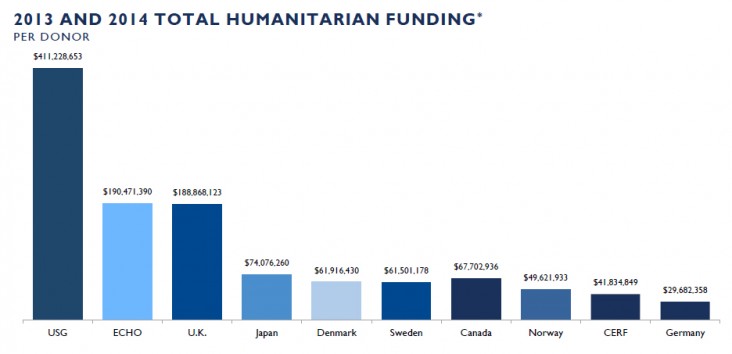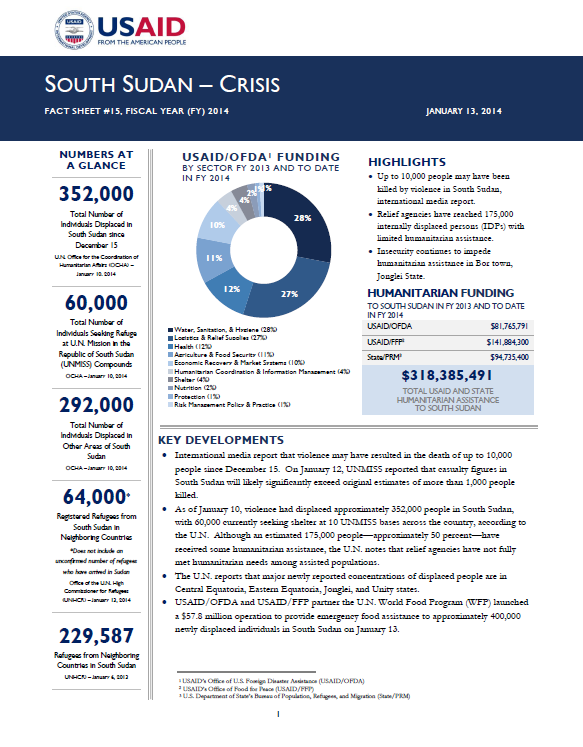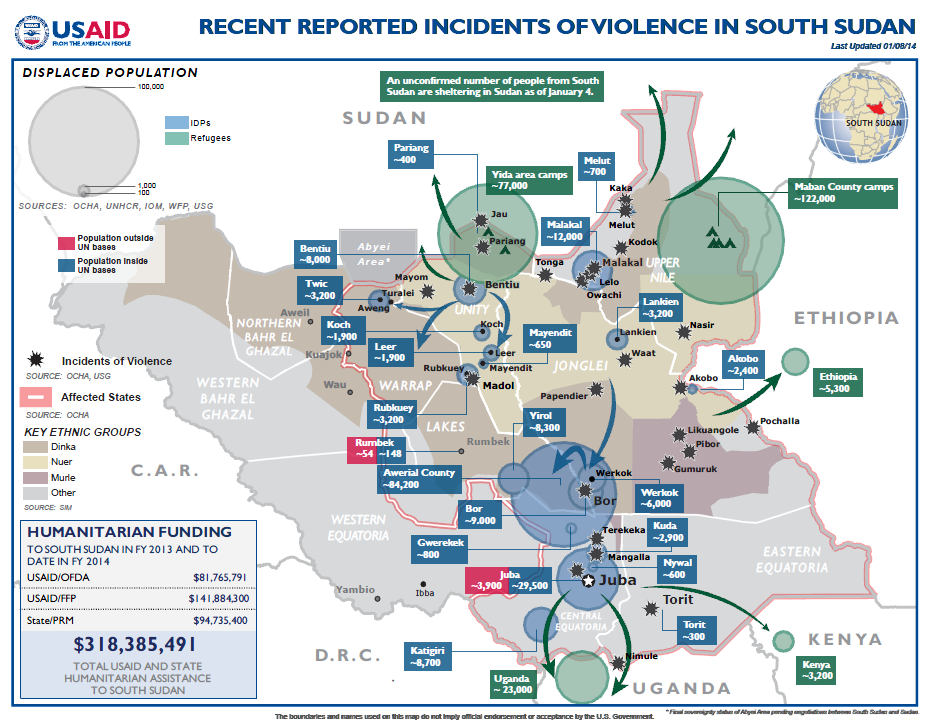- What We Do
- Agriculture and Food Security
- Democracy, Human Rights and Governance
- Economic Growth and Trade
- Education
- Ending Extreme Poverty
- Environment and Global Climate Change
- Gender Equality and Women's Empowerment
- Global Health
- Water and Sanitation
- Working in Crises and Conflict
- Disaster Assistance
- Political Transition Initiatives
- Conflict Mitigation and Prevention
- Countering Violent Extremism
- Disaster Risk Reduction
- Peacebuilding and Reconciliation
- Providing Safe & Secure Environments for Development
- Recovering From Crisis
- Resilience
- Tech Challenge for Atrocity Prevention
- World Humanitarian Day
- U.S. Global Development Lab
February 14, 2014
Numbers At A Glance
707,400
75,300
632,100
149,700
231,600
Humanitarian Funding:
To South Sudan To Date In FY2013 and FY2014:
| USAID/OFDA | $87,174,812 |
| USAID/FFP | $141,884,300 |
| State/PRMDoD | $94,735,400 |
| TOTAL | $323,794,512 |
Highlights
Approximately 707,400 people remain internally displaced in South Sudan as a result of hostilities that began on December 15.
U.N. Under-Secretary-General and Emergency Relief Coordinator Valerie Amos declared the current crisis in South Sudan a Level Three Emergency on February 11.
KEY DEVELOPMENTS
With more than 857,000 people displaced—both internally and as refugees to neighboring countries—as a result of the fighting that erupted in South Sudan on December 15, relief agencies are increasing efforts to coordinate humanitarian response activities for displaced populations and expand response efforts where possible.
Humanitarian access to areas outside of UNMISS bases is limited, and reaching all internally displaced person (IDP) populations remains difficult. Many displaced people are sheltering in remote areas widely dispersed across large portions of the country, while persistent security concerns and access constraints continue to compound difficulties for providing sustained assistance. In addition, humanitarian access to conflict-affected areas is often delayed due to extensive negotiations with armed actors to obtain safety assurances.
The U.N. declared a Level Three Emergency—their highest emergency designation—in South Sudan on February 11 in response to urgent, conflict-driven humanitarian needs related to the protection of civilians, shelter, and pre-positioning of food supplies and relief commodities prior to the upcoming April-to-August rainy season. The heightened emergency designation is intended to enable U.N. agencies to strengthen existing response operations, deploy additional experienced personnel, fast-track administrative procedures, and bolster leadership positions, providing humanitarian organizations with greater capacity to address critical humanitarian needs across South Sudan.
SITUATION, DISPLACEMENT, AND HUMANITARIAN NEEDS UPDATE
While security conditions remain relatively stable in many areas of South Sudan, insecurity continues to affect communities and impede humanitarian access in parts of Lakes, Jonglei, Unity, and Upper Nile states. Since late January, humanitarian organizations have remained unable to access five counties in Jonglei and Unity due to active hostilities, the U.N. reports. Ongoing fighting has particularly hampered emergency response activities in Unity, where violence has displaced approximately 189,500 people. In addition, aid operations continue to face logistical challenges in other remote areas, particularly in Jonglei, where access to opposition-held areas remains challenging, and in Upper Nile, where insecurity and the presence of armed groups has impeded the transportation of fuel and other essential supplies from southern areas.
While distribution of basic food commodities—reaching more than 227,000 people as of February 13—and nutrition supplies continues, more assistance is needed, particularly for people congregating in rural areas who have not integrated into host communities, the U.N. reports.
As challenging conditions and overcrowding persist in UNMISS bases sheltering IDPs, protection actors have observed increased tensions within IDP communities and increased outbreaks of fighting. Relief partners remain particularly concerned regarding an uptick in violent incidents occurring within the civilian protection area at the UNMISS U.N. House 3 base in Juba town, Central Equatoria State. Although two-thirds of IDPs surveyed in recent assessments reported feeling safe at the base, the majority of those who felt unsafe expressed concerns related to volatile security conditions within the site, which relief agencies partially attribute to tensions related to overcrowding and resultant protection, shelter, and water, sanitation, and hygiene (WASH) challenges. Protection actors are engaging with stakeholders to develop constructive solutions to de-escalate tensions.
South Sudan Crisis Fact Sheet #27 February 14, 2014 ![]() (pdf - 373k)
(pdf - 373k)
South Sudan Crisis Map February 14, 2014 ![]() (pdf - 954k)
(pdf - 954k)
HUMANITARIAN RESPONSE ACTIVITIES
Although humanitarian organizations have reached approximately 302,500 people with humanitarian assistance since hostilities erupted on December 15, relief agencies have not fully met needs among assisted populations due to a lack of sustained, predictable access, according to the U.N. Among those assisted, more than 19,700 people have benefited from nutrition activities, and nearly 221,000 people have received WASH assistance. In addition, humanitarian agencies have reached more than 55,000 families with critical shelter and relief commodity support, as well as 183,000 people with protection monitoring and other protection services.
In preparation for the April-to-August rainy season, relief agencies are adjusting plans for pre-positioning humanitarian supplies, focusing on pre-positioning stocks in states least affected by current hostilities and securing sufficient supplies in Juba for onward distribution to conflict-affected areas as needed. Relief agencies have also begun pre-positioning household and emergency shelter items in Bentiu town, Unity, and Bor town, Jonglei, for 2,000 households at each location.
The Logistics Cluster—the coordinating body for humanitarian logistics activities, comprising U.N. agencies, non-governmental organizations (NGOs), and other stakeholders—continues to facilitate the transport of relief items to areas where conflict-affected populations are sheltering. During the week of February 10, relief agencies have delivered 140 metric tons (MT) of relief commodities to five locations in South Sudan. Meanwhile, Logistics Cluster partners are also expanding storage capacity prior to the April-to-August rainy season, with plans to construct up to 11 mobile storage units in the coming weeks. As the WASH Cluster lead, USAID/OFDA partner the U.N. Children’s Fund (UNICEF) plans to erect three additional mobile storage units in Juba and two additional units in Malakal County, Upper Nile, to support the pre-positioning and distribution of WASH kits.
In response to approximately 550 suspected measles cases and 80 associated deaths in South Sudan, relief agencies are increasing efforts to expand immunization campaigns and reach unvaccinated populations across the country. The International Organization for Migration (IOM), UNICEF, and the U.N. World Health Organization (WHO) have transported more than 31,000 doses of measles and oral polio vaccines to Malakal town for a mass vaccination campaign, which had reached more than 13,700 children as of February 13. Once relief agencies complete the vaccination campaign, WHO plans to support routine vaccinations for IDPs in Malakal. As of February 11, nearly 119,000 children between six months and 15 years of age had received measles vaccinations across South Sudan since current hostilities began, according to UNICEF.
Relief agencies continue to expand medical care to displaced populations across South Sudan to respond to significant health challenges. Despite a decrease in the need for emergency trauma medical care as the number of gunshot wound patients has decreased, diseases and illnesses—including malaria, respiratory tract infections, and diarrhea—continue to result in morbidity in IDP sites, according to WHO and the Health Cluster. To stem the risk of malaria, World Vision distributed mosquito nets to displaced households in Malakal in early February, reaching nearly 4,600 people. In Unity, WHO has provided basic medical kits through a local NGO to support health care activities in Koch and Mayendit counties. In addition, the Government of the Republic of South Sudan (RSS) Ministry of Health has delivered 7 MT of medical supplies to the hospital in Bentiu and plans to distribute additional medical supplies to neighboring health facilities in the coming days. Further, community-based disease surveillance and hygiene promotion efforts continue in Bor and Juba to reduce the risk of disease outbreaks among IDP populations.
The U.N. Food and Agriculture Organization (FAO) reports that hostilities in South Sudan have resulted in the displacement of an estimated 10 million livestock and disrupted cold chain supply lines for livestock vaccines since December 15, jeopardizing livestock health and adversely affecting livelihoods among conflict-affected populations. To protect the livelihoods of people dependent on livestock, FAO is procuring new vaccines and expects the medicine to arrive in South Sudan before the end of February. The U.N. has emphasized the importance of restoring livelihoods dependent on livestock, which represent the primary source of employment for a large proportion of the displaced population, noting that with support from donors, relief agencies will distribute animal disease treatment and vaccination kits to community animal health workers and enhance the cold chain capacity to store vaccines.
With $1 million in funding from USAID/OFDA, FAO is providing support for agriculture and food security interventions, including agriculture assistance, conservation agriculture, and livestock disease response across South Sudan. With USAID/OFDA support, FAO also plans to improve access to livestock and fisheries for conflict-affected populations.
As efforts continue to improve coordination among relief agencies, the Camp Coordination and Camp Management (CCCM) Cluster has developed a tool kit to standardize reporting across IDP sites. The tool kit—developed by IOM in its role as the CCCM Cluster co-lead—contains reporting tools and other templates for CCCM partners to use at the state, county, and site levels. This standard structure for consolidating and sharing site information on a weekly basis will allow individual NGOs to better feed into a national picture of needs and response activities in the widespread IDP sites, ultimately facilitating forward planning.
Central Equatoria
Relief organizations remain concerned regarding crowded conditions at the two UNMISS sites—Tong Ping and U.N. House 3—in Juba, where approximately 43,200 IDPs are seeking shelter. Despite relative stability in Juba and difficult living conditions at the UNMISS sites, IDPs reportedly remain fearful to leave the camps and return to areas of origin in Juba. Humanitarian organizations continue to develop plans to decongest Tong Ping and U.N. House 3, taking into consideration IDPs’ concerns and security constraints.
USAID/OFDA is providing $500,000 through the USAID/OFDA-funded, IOM-managed Rapid Response Fund (RRF) to support life-saving health care services at the two UNMISS bases in Juba. With RRF support, the International Medical Corps will provide primary health care and reproductive health services, distribute essential medical supplies and pharmaceuticals, and deploy additional emergency medical staff to respond to health needs among approximately 35,000 IDPs. Since December 15, USAID/OFDA has awarded approximately $2.7 million through the RRF, which allows USAID/OFDA to quickly route funding to international and national NGOs working on the ground in South Sudan to provide assistance to vulnerable populations.
Eastern Equatoria
Relief agencies are planning a distribution of emergency livelihoods kits—including more than 1,100 fishing kits and more than 900 vegetable kits—to displaced and host communities in Eastern Equatoria State, where nearly 60,000 displaced people are seeking shelter. In addition, approximately 8,500 households in Nimule town, close to the Ugandan border, had received household kits as of February 13.
Jonglei
While the security situation in much of Jonglei remained calm during the week of February 10, pockets of IDP populations are reportedly growing in areas outside of Bor, according to the U.N. Although relief workers have limited access to these populations due to the fluid security situation, negotiations are underway to obtain access to these IDPs, who are reportedly in urgent need of humanitarian assistance.
The mortality rate for children under five years of age in Bor remains above emergency thresholds, but mortality rates are expected to improve as humanitarian agencies increase health, nutrition, and WASH interventions in the area, according to the U.N.
Lakes
Relief activities continue in Mingkaman town, Awerial County, Lakes, and surrounding areas for an estimated 84,000 IDPs who have sought shelter in Awerial. Distribution of household and shelter kits is planned for approximately 9,000 households in Mingkaman and surrounding areas in the coming days, the U.N. reports.
Unity
Displaced populations are gradually returning to areas of origin in Bentiu as security conditions remain relatively stable, according to the U.N. During the week of February 10, conflict-affected people outside of the UNMISS compound in Bentiu received food and relief item assistance for the first time since fighting erupted on December 15. USAID/OFDA partner IOM and USAID/FFP partner WFP are registering populations for assistance and distributing food commodities—including oil, pulses, salt, and sorghum—sufficient to meet the needs of up to 20,000 people for 15 days. IOM is also supporting primary health care services for IDPs sheltering at the Bentiu UNMISS base, providing more than 340 health consultations between February 3 and 9.
Although southern counties in Unity remain inaccessible for relief agencies, plans are underway for humanitarian actors to travel to Leer County—sheltering more than 29,000 IDPs as of January 29—in the coming week, security permitting.
Upper Nile
Due to reports of clashes south and west of Malakal town and increased rumors of mobilization in other areas of Upper Nile, the town remains largely empty of civilians, the U.N. reports. The teaching hospital in Malakal has reportedly received several casualties in recent days.
Relief agencies conducted a rapid needs assessment in Dethoma town, Melut County, on January 31, finding urgent food and shelter needs among an estimated 6,000 IDPs in the area. Although community leaders reported that approximately 26,000 IDPs were sheltering in Dethoma, interagency teams remain unable to confirm these estimates. Displaced populations in Dethoma reportedly fled Baliet County following inter-communal fighting that erupted in early January, with additional IDP populations remaining in Melut’s Paloich town, located approximately 35 kilometers south of Dethoma. Displaced families reportedly require food commodities and shelter-related relief supplies—such as blankets, mosquito nets, plastic sheeting, and sleeping mats.
Displaced people continue to arrive in Melut, and relief agencies plan to deploy to the area to assess needs and respond to CCCM concerns.
OTHER HUMANITARIAN ASSISTANCE
To address increased humanitarian needs, the U.N. released a revised South Sudan Crisis Response Plan on February 3, identifying $1.27 billion in humanitarian funding needs. The $1.27 billion requirement includes $741 million to secure all core pipelines for the remainder of the year and $443 million for front-line services through June. Of the funding requested in the revised plan, more than 50 percent would support the Food Security and Livelihoods Cluster to address emergency food needs.

*Funding figures are as of February 14, 2014. All international figures are according to OCHA’s Financial Tracking Service (FTS) and based on international commitments during the 2013 and 2014 calendar years. USG figures are according to the USG and reflect the most recent USG commitments based on the 2013 fiscal year, which began on October 1, 2012, and ended September 30, 2013, as well as the 2014 fiscal year, which began on October 1, 2013.









Comment
Make a general inquiry or suggest an improvement.